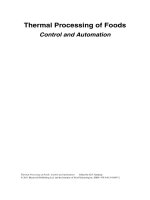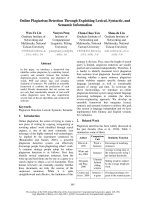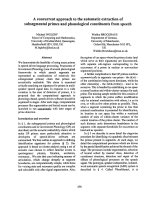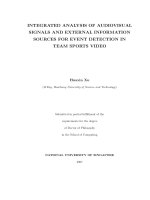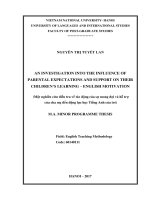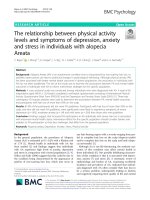Sequential processing of lexical, grammatical, and phonological information within broca���s area
Bạn đang xem bản rút gọn của tài liệu. Xem và tải ngay bản đầy đủ của tài liệu tại đây (1.24 MB, 6 trang )
Sequential Processing of Lexical, Grammatical, and
Phonological Information Within Broca’s Area
Ned T. Sahin, et al.
Science 326, 445 (2009);
DOI: 10.1126/science.1174481
The following resources related to this article are available online at
www.sciencemag.org (this information is current as of October 16, 2009 ):
Updated information and services, including high-resolution figures, can be found in the online
version of this article at:
/>Supporting Online Material can be found at:
/>
This article cites 30 articles, 2 of which can be accessed for free:
/>This article has been cited by 1 articles hosted by HighWire Press; see:
/>This article appears in the following subject collections:
Neuroscience
/>Information about obtaining reprints of this article or about obtaining permission to reproduce
this article in whole or in part can be found at:
/>
Science (print ISSN 0036-8075; online ISSN 1095-9203) is published weekly, except the last week in December, by the
American Association for the Advancement of Science, 1200 New York Avenue NW, Washington, DC 20005. Copyright
2009 by the American Association for the Advancement of Science; all rights reserved. The title Science is a
registered trademark of AAAS.
Downloaded from www.sciencemag.org on October 16, 2009
A list of selected additional articles on the Science Web sites related to this article can be
found at:
/>
REPORTS
References and Notes
1.
2.
3.
4.
5.
G. Nelson et al., Cell 106, 381 (2001).
G. Nelson et al., Nature 416, 199 (2002).
X. Li et al., Proc. Natl. Acad. Sci. U.S.A. 99, 4692 (2002).
E. Adler et al., Cell 100, 693 (2000).
J. Chandrashekar et al., Cell 100, 703 (2000).
6. H. Matsunami, J. P. Montmayeur, L. B. Buck, Nature 404,
601 (2000).
7. K. L. Mueller et al., Nature 434, 225 (2005).
8. A. L. Huang et al., Nature 442, 934 (2006).
9. Y. Ishimaru et al., Proc. Natl. Acad. Sci. U.S.A. 103,
12569 (2006).
10. N. D. Lopezjimenez et al., J. Neurochem. 98, 68 (2006).
11. Y. Zhang et al., Cell 112, 293 (2003).
12. G. Q. Zhao et al., Cell 115, 255 (2003).
13. A. A. Kawamura, in Olfaction and Taste II, T. Hayashi, Ed.
(Pergamon, New York, 1967), pp. 431–437.
14. M. Komai, B. P. Bryant, T. Takeda, H. Suzuki, S. Kimura,
in Olfaction and Taste XI, K. Kurihara, N. Suzuki,
H. Ogawa, Eds. (Springer-Verlag, Tokyo, 1994), pp. 92.
15. V. Lyall et al., Am. J. Physiol. Cell Physiol. 281, C1005
(2001).
16. J. M. Dessirier, C. T. Simons, M. O’Mahony, E. Carstens,
Chem. Senses 26, 639 (2001).
17. C. T. Simons, J. M. Dessirier, M. I. Carstens, M. O’Mahony,
E. Carstens, J. Neurosci. 19, 8134 (1999).
18. J. Hu et al., Science 317, 953 (2007).
19. S. Lahiri, R. E. Forster 2nd, Int. J. Biochem. Cell Biol. 35,
1413 (2003).
20. M. Dahl, R. P. Erickson, S. A. Simon, Brain Res. 756, 22
(1997).
21. J. Chandrashekar, M. A. Hoon, N. J. Ryba, C. S. Zuker,
Nature 444, 288 (2006).
22. M. Komai, B. P. Bryant, Brain Res. 612, 122 (1993).
23. L. G. Miller, S. M. Miller, J. Fam. Pract. 31, 199
(1990).
24. M. Graber, S. Kelleher, Am. J. Med. 84, 979 (1988).
25. D. Brown, L. M. Garcia-Segura, L. Orci, Brain Res. 324,
346 (1984).
26. H. Daikoku et al., Chem. Senses 24, 255 (1999).
27. B. Bottger, T. E. Finger, B. Bryant, Chem. Senses 21, 580
(1996).
28. Y. Akiba et al., Gut 57, 1654 (2008).
29. C. T. Supuran, Curr. Pharm. Des. 14, 603 (2008).
30. W. S. Sly, P. Y. Hu, Annu. Rev. Biochem. 64, 375 (1995).
31. T. Okuyama, A. Waheed, W. Kusumoto, X. L. Zhu,
W. S. Sly, Arch. Biochem. Biophys. 320, 315 (1995).
32. G. N. Shah et al., Proc. Natl. Acad. Sci. U.S.A. 102,
16771 (2005).
33. D. Vullo et al., Bioorg. Med. Chem. Lett. 15, 971
(2005).
34. M. Yamamoto et al., J. Neurosci. 23, 6759 (2003).
35. C. R. Yu et al., Neuron 42, 553 (2004).
36. Y. Zhang et al., Neuron 60, 84 (2008).
37. G. S. Suh et al., Nature 431, 854 (2004).
38. W. Fischler, P. Kong, S. Marella, K. Scott, Nature 448,
1054 (2007).
39. We thank W. Guo and A. Becker for generation and
maintenance of mouse lines, M. Hoon for help in the
initial phase of this work, E. R. Swenson for a generous
gift of benzolamide, M. Goulding for Rosa26-flox-STOPTeNT mice, A. Waheed for Car4 antibodies, and members
of the Zuker laboratory for valuable comments.
Supported in part by the intramural research program of
the NIH, NIDCR (N.J.P.R.). C.S.Z. is an investigator of the
Howard Hughes Medical Institute.
Downloaded from www.sciencemag.org on October 16, 2009
the basic taste modalities is mediated by distinct
TRCs, with taste at the periphery proposed to be
encoded via labeled lines [i.e., a sweet line, a sour
line, a bitter line, etc. (21)]. Given that Car4 is
specifically tethered to the surface of sour-sensing
cells, and thus ideally poised to provide a highly
localized acid signal to the sour TRCs, we reasoned that carbonation might be sensed through
activation of the sour-labeled line. A prediction of
this postulate is that prevention of sour cell activation should eliminate CO2 detection, even in the
presence of wild-type Car4 function. To test this
hypothesis, we engineered animals in which the
activation of nerve fibers innervating sour-sensing
cells was blocked by preventing neurotransmitter
release from the PKD2L1-expressing TRCs. In essence, we transgenically targeted expression of tetanus toxin light chain [TeNT, an endopeptidase
that removes an essential component of the synaptic machinery (34–36)] to sour-sensing TRCs,
and then monitored the physiological responses of
these mice to sweet, sour, bitter, salty, umami and
CO2 stimulation. As predicted, taste responses to
sour stimuli were selectively and completely abolished, whereas responses to sweet, bitter, salty and
umami tastants remained unaltered (Fig. 4 and
fig. S5). However, these animals also displayed a
complete loss of taste responses to CO2 even
though they still expressed Car4 on the surface of
PKD2L1 cells. Together, these results implicate
the extracellular generation of protons, rather than
intracellular acidification (15), as the primary signal that mediates the taste of CO2, and demonstrate
that sour cells not only provide the membrane anchor for Car4 but also serve as the cellular sensors
for carbonation.
Why do animals need CO2 sensing? CO2 detection could have evolved as a mechanism to
recognize CO2-producing sources (18, 37)—for
instance, to avoid fermenting foods. This view
would be consistent with the recent discovery of
a specialized CO2 taste detection in insects where
it mediates robust innate taste behaviors (38). Alternatively, Car4 may be important to maintain
the pH balance within taste buds, and might gratuitously function as a detector for carbonation
only as an accidental consequence. Although CO2
activates the sour-sensing cells, it does not simply
taste sour to humans. CO2 (like acid) acts not only
on the taste system but also in other orosensory
pathways, including robust stimulation of the
somatosensory system (17, 22); thus, the final
percept of carbonation is likely to be a combination of multiple sensory inputs. Nonetheless,
the “fizz” and “tingle” of heavily carbonated
water is often likened to mild acid stimulation of
the tongue, and in some cultures seltzer is even
named for its salient sour taste (e.g., saurer
Sprudel or Sauerwasser).
Supporting Online Material
www.sciencemag.org/cgi/content/full/326/5951/443/DC1
Materials and Methods
Figs. S1 to S5
References
6 April 2009; accepted 17 August 2009
10.1126/science.1174601
Sequential Processing of Lexical,
Grammatical, and Phonological
Information Within Broca’s Area
Ned T. Sahin,1,2* Steven Pinker,2 Sydney S. Cash,3 Donald Schomer,4 Eric Halgren1
Words, grammar, and phonology are linguistically distinct, yet their neural substrates are difficult
to distinguish in macroscopic brain regions. We investigated whether they can be separated in
time and space at the circuit level using intracranial electrophysiology (ICE), namely by recording
local field potentials from populations of neurons using electrodes implanted in language-related
brain regions while people read words verbatim or grammatically inflected them (present/past or
singular/plural). Neighboring probes within Broca’s area revealed distinct neuronal activity for lexical
(~200 milliseconds), grammatical (~320 milliseconds), and phonological (~450 milliseconds) processing,
identically for nouns and verbs, in a region activated in the same patients and task in functional magnetic
resonance imaging. This suggests that a linguistic processing sequence predicted on computational
grounds is implemented in the brain in fine-grained spatiotemporally patterned activity.
ithin cognitive neuroscience, language
is understood far less well than sensation, memory, or motor control, because language has no animal homologs, and
methods appropriate to humans [functional magnetic resonance imaging (fMRI), studies of braindamaged patients, and scalp-recorded potentials]
W
1
Department of Radiology, University of California–San
Diego, La Jolla, CA 92037, USA. 2Department of Psychology,
Harvard University, Cambridge, MA 02138, USA. 3Department
of Neurology, Massachusetts General Hospital, Boston, MA
02114, USA. 4Department of Neurology, Beth Israel Deaconess
Medical Center, Boston, MA 02215, USA.
*To whom correspondence should be addressed. E-mail:
www.sciencemag.org
SCIENCE
VOL 326
are far coarser in space or time than the underlying causal events in neural circuitry. Moreover,
language involves several kinds of abstract information (lexical, grammatical, and phonological)
that are difficult to manipulate independently.
This has left a gap in understanding between the
computational structure of language suggested
by linguistics and the neural circuitry that implements language processing. We narrow this gap
using a technique with high spatial, temporal, and
physiological resolution and a task that distinguishes
three components of linguistic computation.
According to linguistic analyses, the ability to
identify words, combine them grammatically, and
articulate their sounds involves several kinds of
16 OCTOBER 2009
445
representations, with logical dependencies among
them (1, 2). For example, to pronounce a verb in
a sentence, one must determine the appropriate
tense given the intended meaning and syntactic
context (e.g., “walk,” “walks,” “walked,” or “walking”). One must identify the particular verb, which
specifies whether to use a regular (e.g., “walked”)
or irregular (e.g., “went”) form. In addition, one
must unpack the phonological content of the verb
and suffix to implement three more computations: phonological adjustments in the sequence of
phonemes (e.g., inserting a vowel between verb and
suffix in “patted” but not in “walked”), phonetic
adjustments in the pronunciation of the phonemes
(such as the difference between the “d” in “walked”
and “jogged”), and conversion of the phoneme sequence into articulatory motor commands.
This logical decomposition does not entail that
each kind of representation corresponds to a distinct
stage or circuit in the brain. In many neural-network
models, the selection of tense, discrimination of
regular from irregular inflection, and formulation
of the phonetic output are computed in parallel
and in one time-step within a single distributed
Fig. 1. Experimental design. (A) Structure of trials. (B) Experimental conditions, example trials,
and required psycholinguistic processes. (C) Hypothesized patterns of neural activity by condition,
for inflectional and phonological processing.
Fig. 2. (A) Main results:
sequential processing of
lexical, grammatical,
and phonological information in overlapping
circuits. (Top) Neural activity recorded from several channels in Broca’s
area (patient A, Brodmann
area 45) shows three LFP
components that were
consistently evoked by
the task (~200, ~320,
and ~450 ms). (Bottom)
The ~200-ms component is sensitive to word
frequency but not word
length, suggesting that
it indexes a cognitive
process such as lexical
identification, not simply
perception. Stacked waveforms (top and bottom)
adopt the axes noted on
the first waveform. (B) At
~320 ms, the LFP pattern suggests inflectional
processing. (C) At ~450 ms, in a channel 5 mm distant, the complementary pattern
suggests phonological processing. (Inset) MRI slices from this patient, annotated
with the anatomical location of A4, the contact in common to the two channels
446
16 OCTOBER 2009
VOL 326
network (3, 4). Others contain loops and feedback
connections, propagate probabilistic constraints,
and iteratively settle into a globally stable state,
with no fixed sequence of operations (5). Even
stage models may incorporate cascades where
partial information from one stage begins to feed
the next before its computation is complete (6).
Nonetheless, the most comprehensive model of
speech production, developed by Levelt, Roelofs,
and Meyer (LRM), maximizes parsimony and falsifiability by implementing linguistic operations
as discrete ordered stages, eschewing feedback,
loops, parallelism, or cascades (7). They posit
stages for lexical retrieval (which they associate
with the left middle temporal gyrus at 150 to 225
ms after stimulus presentation), grammatical encoding (locus and duration unknown), phonological retrieval (posterior temporal lobe, 200 to
400 ms), phonological and phonetic processing
(Broca’s area, 400 to 600 ms), self-monitoring
(superior temporal lobe, beginning at 275 to 400
ms but highly variable in duration), and articulation (motor cortex) (8, 9).
Current evidence, however, leaves considerable uncertainty about the localization and timing of these components, especially grammatical
processing. Although clinical studies report double dissociations in which a patient is more impaired in grammar than phonology or vice versa
(10), in most studies both abilities are linked to
similar regions in the left inferior prefrontal cortex,
particularly Broca’s area (11). Although Broca’s
area itself has been identified as the seat of phonology, grammar, and even specific grammatical
operations (12–14), lesion and neuroimaging
reported here. Statistical significance: **** (P < .0001), *** (P < .001), ** (P < .01) (t
test, one tail, two-sample, equal variance). Box arrows (bottom) indicate linguistic
processing stages, which may be interposed among other stages not addressed here.
SCIENCE
www.sciencemag.org
Downloaded from www.sciencemag.org on October 16, 2009
REPORTS
REPORTS
ing to grammatical rules, but the units are shorter
and semantically simpler, making fewer demands
on working memory and conceptual integration,
and thus allowing greater experimental control.
We applied the high resolution of ICE to a task
that distinguishes three linguistic processes to investigate the spatiotemporal patterning of word
production in the brain.
In each trial, participants saw either the
instruction “Repeat word” (the “Read” condition)
or a cue that dictated an inflected form (“Every
day they ____”; “Yesterday they ____”; “That is
a ____”; “Those are the ____”). Next, they saw a
target word and produced the appropriate form
silently (Fig. 1A) (16). The 240 target words
were presented in uninflected form in the phrase
“a [noun]” or “to [verb]” (17) (Fig. 1B). Half the
targets were regular (e.g., “link”/“linked”) and
half irregular (e.g., “think”/“thought”), to ensure
that participants had to access the word rather than
automatically appending the regular suffix (18).
The Null-Inflect (N) condition requires an
inflected form of the verb (present tense) or noun
(singular), yet these forms are not overtly marked
and thus require the same output to be pronounced
as in the Read (R) condition. The difference between these conditions thus implicates the process
of inflection. In contrast, the Overt-Inflect (O) condition (past-tense verb or plural noun) requires
that a suffix be added (regular) or the form changed
(irregular). It thus differs from the Null-Inflect
condition in requiring computation of a different
phonological output (Fig. 1B). (The label “phonological” subsumes phonological, phonetic, and
articulatory processes.) The design was fully crossed,
with trials presented in pseudorandom order.
To assess whether these patients’ language
systems were organized normally, and to correlate
LFP with fMRI, we performed fMRI in two of the
patients before their electrodes were placed. Their
activation patterns were indeed similar to 18
healthy controls (Fig. 3, A to C) [for other fMRI
results, see (19)]. Most of the 168 bipolar channels
from which we recorded (across patients) were in
fMRI-active regions (Fig. 3, A to G). LFP that
was significantly correlated with the task (P <
.001, corrected) [see (16)] was recorded in about
half (86 of 168) of the channels (19 channels in
Downloaded from www.sciencemag.org on October 16, 2009
studies have tied it to a broad variety of linguistic
and nonlinguistic processes (15). This uncertainty
may be a consequence of the coarseness of current
measurements. It remains possible that grammatical and other linguistic processes are processed
distinctly, even sequentially, in the microcircuitry
of the brain, but techniques that sum over seconds
and centimeters necessarily blur them.
In a rare procedure, electrodes are implanted
in the brains of patients with epilepsy for clinical
evaluation. Recordings of intracranial electrophysiology (ICE) from unaffected brain tissue
during periods of normal activity can provide
millisecond resolution in time with millimeter
resolution in space. We recorded local field potentials (LFP) from multicontact depth electrodes in three right-handed patients (ages 38 to
51, with above-average language and cognitive
skills) whose electrodes were located in and around
Broca’s area while they read words verbatim or
converted them to an inflected form (past/present
or singular/plural) (Figs 1 and 2) (16). The task
engages inflectional morphology, which is like
syntax in combining meaningful elements accord-
www.sciencemag.org
SCIENCE
VOL 326
16 OCTOBER 2009
-
+
+
-
Fig. 3. Localization of A fMRI (18 healthy volunteers)
H
E Electrode Implantation
fMRI responses, depth
(Pt. A)
(Pt. A)
electrodes, and neural
generators. (A) fMRI in 18
l
controls, contrasting activnta
Left Medial
Fro 44
ity for all task conditions
(Inflated)
A
44
with visual-fixation base45
Left Lateral
al
45
line periods. The task enpor
m
e
B
47
T
gages classic language B fMRI (Patient A)
areas (Broca’s, speechrelated motor cortex, me.001
dial supplementary motor
Probe A - Anatomical Trajectory
.005
.01
area, anterior cingulate,
F Depth Probe B Trajectory
p (corrected: FDR)
Schematic of Neuronal
I
and superior temporal
(Pt. A)
.01
Dipole Model (at 320ms)
lobe) and visual-reading
.005
.001
areas (visual word form
area and primary and C fMRI (Pt. C)
1
ventral visual cortex). Clas6
sic Broca’s area is circled.
.001
.01
Thresholding and correc((Probe A)
.05
tion at a 0.01 false discovFDR
.05
Left
ery rate (16). Scale as in
.01
.001
(B). (B and C) Singlepatient fMRI (identical D
G
Depth Electrode Probes
Physiological Dynamics
J
fMRI activation near probe B
contrast) reveals similar
within Local Network
(Pt.
C)
activations in both pa(Pt. A)
tients and controls. Surfaces
A
are inflated to reveal activation within sulci. (D)
200 ms
Coregistered MRI and
320
B
computerized tomogra450+
phy scan of patient C
showing depth probes
Left
inserted through the skull.
(E) Intra-operative photo
showing left perisylvian
language areas. Letters, insertion points of the probes; dashed lines, surface task in this patient. (H) Location of probe A, in Broca’s area traversing IFG pars
projections of their intracortical trajectories. Putative Brodmann areas are triangularis within the inferior frontal sulcus. (I and J) Schematic of neural
labeled. (F) Postimplantation MRI reveals that probe B traverses Broca’s area in dipoles near probe A that generated the LFP components, hypothesized from
the posteromedial process of IFG pars opercularis facing the insula, and their polarities, amplitudes, and locations (see fig. S3). Schematic gyral
preimplantation fMRI (G) demonstrates that the region was activated by the outline corresponds to the gyral trace superimposed on the MRI in (H).
447
0
500
1000
1500 ms
Pt. A
Pt. B
Pt. C
Superior
Temporal
Noun vs. Verb Inflection
Broca’s
Pt. A
Pt. B
Pt. C
B
Pt. A, A5-6
Pt. A, A3-4
Pt. B, B5-6
Pt. C, B5-6
0
500
320 450
Pt. C, C3-4
Pt. C, C4-5
Pt. C, D4-5
(155-235 trials per trace)
**
Simple (1-syllable)
Complex (3 & 4-syll)
(Pt. A, Ch. A3-4)
-50
0
Cue
Channels
(Pt. A)
Target Word
B6-7
B5-6
B4-5
B3-4
B2-3
100
µV/cm
Potential
Gradient 50
(µV/cm)
D Cue Epoch vs. Response Epoch
Phonological Complexity
of Response Word
Target Word
1500 ms
Pt. B, C5-6
Pt. B, C2-3
(465-550 trials per trace)
C Confirmation of Phonological Processing
1000
Superior
Temporal
Broca’s
Area
Potential Gradient
(scaled)
A Regional Specificity of Triphasic LFP
11 characters) words (Fig. 2A), nor a difference
between one-morpheme and two-morpheme responses (26). Later components were not affected
by frequency. Finally, consistent with the fact that
lexical identification is required by all three
inflectional conditions, the ~200-ms component
did not vary across them. Primary lexical access
is generally associated with temporal cortex
rather than Broca’s area (8), so this component
may index delivery of word identity information
into Broca’s area for subsequent processing,
consistent with anatomic and physiological evidence that the two areas are integrated (23, 27).
Although word-evoked activity in this latency
range has previously been localized to Broca’s
area with LFP (28) and magnetoencephalography (29), it has not been demonstrated to be
modulated by lexical frequency.
The subsequent two LFP components
showed activity patterns predicted for grammatical and phonological processing, respectively
(Fig. 2, B and C). In the ~320-ms component
(Fig. 2B), the Overt-Inflect and Null-Inflect
conditions significantly differed from the Read
condition but not from each other. Thus, the
~320-ms component is modulated by the demands of inflection (required by Overt-Inflect
and Null-Inflect but not Read), but not by the
demands of phonological programming (required
in Overt-Inflect but not in Null-Inflect or Read;
Potential Gradient
(scaled)
patient A, 37 in B, and 30 in C). Of these
channels, 49 (57%) were within Broca’s area or
the anterior temporal lobes (16 in patient A, 19
in B, 14 in C). Of the 49 channels, 26 were
within Broca’s area, and the majority (20 of 26)
yielded a strong triphasic (three-component) LFP
waveform (9 in patient A, 8 in B, 3 in C). The
mean peaks occurred ~200, ~320, and ~450 ms
after the target word onset (Fig. 2A), and this
timing was consistent across patients (Fig. 4, A
and B, and figs. S1, S4, and S5).
The three LFP components showed signatures of distinct linguistic processing stages
(Fig. 2, A to C). The ~200-ms component appears to reflect lexical identification. The timing
converges with when word-specific activity has
previously been recorded in the visual word
form area (VWFA) [(20, 21), but see (22)] and
when the VWFA has been shown to become
phase-locked with Broca’s area (23). Furthermore, the magnitude of the component varied
with word frequency, which indexes lexical
access (24). Specifically, rare words (frequency
1 to 4) yielded a significantly higher amplitude
[t(204) = 3.32, P < 0.001] than common words
(frequency 9 to 12) (Fig. 2A) (25). Word frequency is inversely correlated with word length,
but the present effect is not a consequence of
length: We found no difference at ~200 ms between short (2 to 4 characters) and long (6 to
50
-50
1000 ms
Overt- & Null-Inflect
(310 trials per trace)
0
1000
2000 0
1000
2000 ms
Fig. 4. Additional features of the triphasic waveform support the lexical-inflectional-phonological progression. (A) Triphasic activity is specific to Broca’s area and is consistent across patients. All-condition
average waveforms from task-active channels in each patient are superimposed (scaled in amplitude to a
single channel in each region and standardized in polarity). (B) Noun (black) and verb (red) inflection (Null
and Overt combined) involved nearly identical neural activity, across sites and patients. Standardized across
channels in polarity. (C) The ~450-ms component, which is sensitive to phonological differences among
inflectional conditions, is also sensitive to phonological complexity (syllable count) of the target word (P <
0.01, corrected). (D) Neural activity in Broca’s area is evoked primarily when processing the target word
(when the linguistic processing of interest should occur), not the cue (35).
448
16 OCTOBER 2009
VOL 326
SCIENCE
see Fig. 1C). In contrast, in a component appearing at ~450 ms, Overt-Inflect did differ from the
Null-Inflect and Read conditions, which did not
differ from each other (Fig. 2C). This contrasting
pattern indicates that the ~450-ms component
reflects phonological, phonetic, and articulatory programming, independently confirmed by its
sensitivity to the number of syllables (Fig. 4C).
Both components were recorded from Broca’s
area in all patients (fig. S1), and specifically in
patient A (Fig. 2) from the inferior frontal gyrus
(IFG) pars triangularis deep in the inferior frontal
sulcus. The ~320-ms component was recorded near
the fundus; the ~450-ms component was recorded
5 mm more lateral along the sulcus within a subgyral fold that faced the fundus (Fig. 3I and fig.
S1A). This region is often considered part of area
45 [but see (30)].
The pattern of sign inversions across neighboring bipolar channels in space (Fig. 2A, top)
indicates that the generators of the LFP components were local (fig. S3), and the differences in
inversions across components in time indicate
that their generators were not identical (Fig. 3, I
and J). Thus, the overall LFP pattern suggests a
fine-grain spatiotemporal progression of lexical, grammatical, and phonological processing
within Broca’s area during word production.
The triphasic pattern in all patients was found
exclusively in Broca’s area (Fig. 4A). Outside
Broca’s area, other patterns prevailed; for example, temporal lobe sites showed a slow and late
monophasic component at 500 to 600 ms (Fig.
4A, bottom, and fig. S4, F and G) (31), possibly
reflecting self-monitoring (7, 8). The condition
differences for each component were also consistent across patients, replicating the temporal
isolation of grammatical (~320 ms) from phonological (~450 ms) processing (fig. S1). The wordfrequency effect on the ~200-ms component was
significant in patients A and B and marginal (P =
0.06) in patient C (fig. S2). The ~200-, ~320-,
and ~450-ms components were consistent in
their timing across patients, although the keypress
reaction times, which require the self-monitoring
process, varied among patients and conditions
(fig. S6).
Although nouns and verbs differ linguistically
and neurobiologically (32, 33), the neuronal activity they evoked was similar (Fig. 4B). Furthermore, the patterning across inflectional conditions
was the same for nouns and verbs (34). These
parallels suggest that words from different lexical
classes feed a common process for inflection.
Additional evidence that the LFP patterns
reflect inflectional computation is that they are
triggered by presentation of the target word, not
the cue, even though the cues contain more visual
and linguistic elements (Fig. 4D) (35). Furthermore, activity evoked by the cue showed little
sensitivity to the inflectional conditions.
The LFP patterns are consistent with the computational nature of the task and with independent
estimates of the timing of its subprocesses. Inflectional processing cannot occur before the word
www.sciencemag.org
Downloaded from www.sciencemag.org on October 16, 2009
REPORTS
REPORTS
References and Notes
1.
2.
3.
4.
5.
6.
7.
8.
9.
10.
11.
12.
13.
14.
15.
S. Pinker, The Language Instinct (HarperColllins, 1994).
S. Pinker, Science 253, 530 (1991).
K. Plunkett, V. Marchman, Cognition 38, 43 (1991).
B. MacWhinney, J. Leinbach, Cognition 40, 121 (1991).
M. F. Joanisse, M. S. Seidenberg, Proc. Natl. Acad. Sci.
U.S.A. 96, 7592 (1999).
J. L. McClelland, Psychol. Rev. 86, 287 (1979).
W. J. M. Levelt, A. Roelofs, A. S. Meyer, Behav. Brain Sci.
22, 1 (1999).
P. Indefrey, W. J. M. Levelt, Cognition 92, 101 (2004).
D. P. Janssen, A. Roelofs, W. J. M. Levelt, Lang. Cogn.
Process. 17, 209 (2002).
N. Dronkers, Nature 384, 159 (1996).
We use “Broca’s area” to denote the left IFG pars
opercularis and pars triangularis [classically, Brodmann
areas 44 and 45, but see (30)].
P. Broca, Bulletin de la Société Anatomique 6, 330
(1861).
E. Zurif, A. Caramazza, R. Myerson, Neuropsychologia 10,
405 (1972).
Y. Grodzinsky, Behav. Brain Sci. 23, 1 (2000).
E. Kaan, T. Y. Swaab, Trends Cogn. Sci. 6, 350
(2002).
16. Materials and methods are available as supporting
material on Science Online.
17. The context words (“a” and “to”) prevented participants
from simply concatenating the cue and target (a strategy
that would succeed in two-thirds of the trials) and helped
equalize difficulty across conditions.
18. Differences in the signals between regular and irregular
verbs are not analyzed here [for discussion, see (19)].
19. N. T. Sahin, S. Pinker, E. Halgren, Cortex 42, 540 (2006).
20. L. Cohen, S. Dehaene, Neuroimage 22, 466 (2004).
21. A. C. Nobre, T. Allison, G. McCarthy, Nature 372, 260
(1994).
22. C. J. Price, J. T. Devlin, Neuroimage 19, 473 (2003).
23. N. T. Sahin et al., Neuroimage 36, S74 (2007).
24. O. Hauk, F. Pulvermuller, Clin. Neurophysiol. 115, 1090
(2004).
25. Frequency score was the rounded natural log of the
combined frequencies of all inflectional forms of a word,
plus one.
26. These factors were largely independent. Word length
correlated little with morpheme count (0.267) or
frequency (–0.347).
27. A. D. Friederici, Trends Cogn. Sci. 13, 175 (2009).
28. E. Halgren et al., J. Physiol. (Paris) 88, 51 (1994).
29. K. Marinkovic et al., Neuron 38, 487 (2003).
30. K. Amunts et al., J. Comp. Neurol. 412, 319 (1999).
31. This component may approximate the P600 component
often recorded from the scalp (42), but comparisons are
difficult because the P600 is generally elicited by errors,
in comprehension rather than production experiments.
32. A. Caramazza, A. E. Hillis, Nature 349, 788 (1991).
33. K. Shapiro, A. Caramazza, Trends Cogn. Sci. 7, 201
(2003).
34. The exception was that, for nouns, the Overt-Read
comparison at ~320 and the Overt-Null comparison at
~450 ms only approached significance (P = 0.08 and
0.06, respectively; one-tailed t test).
35. We measured the average amplitude of the rectified allconditions LFP in Broca’s area channels in all patients, in
the 150- to 650-ms interval, embracing our components
of interest. The response epoch had a higher amplitude
than the cue epoch in most (20 of 26) channels, and
36.
37.
38.
39.
40.
41.
42.
43.
across all channels was 99% greater. [Patient A yielded a
higher amplitude in the response epoch in 7 of 10
channels, on average 71.7% higher; patient B in 7 of 10
channels (+33.6% on average); and patient C in 6 of
6 channels (+191.6% on average)].
R. Gaillard et al., Neuron 50, 191 (2006).
A. D. Friederici, Trends Cogn. Sci. 6, 78 (2002).
LFP components reported here vary by amplitude but not
latency or duration; evidently, the processes they index
are consistently timed, and other processes [e.g.,
assembly and enactment of the articulatory plan (8)]
produce the differences in response latency.
P. Hagoort, Trends Cogn. Sci. 9, 416 (2005).
I. Bornkessel, M. Schlesewsky, Psychol. Rev. 113, 787
(2006).
However, the fine-grained, within-gyrus localization
reported here cannot easily be mapped onto the more
macroscopic divisions suggested by these authors.
A. D. Friederici, Clin. Neurosci. 4, 64 (1997).
Supported by NIH grants NS18741 (E.H.), NS44623
(E.H.), HD18381 (S.P.), T32-MH070328 (N.T.S.), NCRR
P41-RR14075; and the Mental Illness and Neuroscience
Discovery (MIND) Institute (N.T.S.), Sackler Scholars
Programme in Psychobiology (N.T.S.), and Harvard Mind/
Brain/Behavior Initiative (N.T.S.). We heartily thank the
patients. We also thank E. Papavassiliou and J. Wu for
access to their patients; S. Narayanan, N. Dehghani,
M. T. Wheeler, F. Kampmann, and L. Gruber for
assistance with intracranial electrophysiological data;
R. Raizada for manuscript suggestions; N. M. Sahin;
and two anonymous reviewers whose suggestions and
encouragement greatly improved this paper.
Downloaded from www.sciencemag.org on October 16, 2009
is identified (especially as to whether it is regular
or irregular), and phonological, phonetic, and articulatory processing cannot be computed before
the phonemes of the inflected form have been
determined. Word identification has been shown
to occur at 170 to 250 ms (8, 29, 36), consistent
with the ~200-ms component, and syllabification and other phonological processes at 400 to
600 ms, consistent with the phonological component at 400 to 500 ms (8). In naming tasks,
speech onset occurs at around 600 ms (8), which
is consistent with the self-monitoring behavioral
responses we recorded (fig. S6). Self-monitoring
has been localized to the temporal lobe (8), where
we recorded LFPs in the post-response latency
range that may correspond to previously described
scalp event-related potentials (37). Working backward from 600 ms, we note that motor neuron
commands occur 50 to 100 ms before speech,
placing them just after the phonological component we found to peak at 400 to 500 ms (38).
In sum, the location, behavioral correlates, and
timing of the components of neuronal activity
in Broca’s area suggest that they embody, respectively, lexical identification (~200 ms), grammatical inflection (~320 ms), and phonological
processing (~450 ms) in the production of nouns
and verbs alike.
Although the language processing stream
as a whole surely exhibits parallelism, feedback, and interactivity, the current results support parsimony-based models such as LRM (7),
in which one portion of this stream consists of
spatiotemporally distinct processes corresponding to levels of linguistic computation. Among
the processes identified by these higher-resolution
data is grammatical computation, which has been
elusive in previous, coarser-grained investigations. As such, the results are also consistent with
recent proposals that Broca’s area is not dedicated
to a single kind of linguistic representation but is
differentiated into adjacent but distinct circuits
that process phonological, grammatical, and lexical information (37, 39–41).
Supporting Online Material
www.sciencemag.org/cgi/content/full/326/5951/445/DC1
Materials and Methods
Figs. S1 to S6
Tables S1 and S2
References
3 April 2009; accepted 28 August 2009
10.1126/science.1174481
Fast Synaptic Subcortical Control of
Hippocampal Circuits
Viktor Varga,1*† Attila Losonczy,2*†‡ Boris V. Zemelman,2* Zsolt Borhegyi,1 Gábor Nyiri,1
Andor Domonkos,1 Balázs Hangya,1 Noémi Holderith,1 Jeffrey C. Magee,2 Tamás F. Freund1
Cortical information processing is under state-dependent control of subcortical neuromodulatory
systems. Although this modulatory effect is thought to be mediated mainly by slow nonsynaptic
metabotropic receptors, other mechanisms, such as direct synaptic transmission, are possible. Yet, it is
currently unknown if any such form of subcortical control exists. Here, we present direct evidence of a
strong, spatiotemporally precise excitatory input from an ascending neuromodulatory center. Selective
stimulation of serotonergic median raphe neurons produced a rapid activation of hippocampal
interneurons. At the network level, this subcortical drive was manifested as a pattern of effective
disynaptic GABAergic inhibition that spread throughout the circuit. This form of subcortical network
regulation should be incorporated into current concepts of normal and pathological cortical function.
ubcortical monoaminergic systems are
thought to modulate target cortical networks on a slow time scale of hundreds of
milliseconds to seconds corresponding to the duration of metabotropic receptor signaling (1).
Among these ascending systems, the serotonergic
raphe-hippocampal (RH) pathway that primarily
originates within the midbrain median raphe nucleus (MnR) is a key modulator of hippocampal
mnemonic functions (2). Contrary to the slow
S
www.sciencemag.org
SCIENCE
VOL 326
modulatory effect commonly associated with
ascending systems, electrical stimulation of the
RH pathway produces a rapid and robust modulation of hippocampal electroencephalographic
activity (3–5). Anatomical evidence shows that
MnR projections form some classical synapses
onto GABAergic interneurons (INs) in the hippocampus (6), potentially providing a substrate for
a fast neuromodulation of the hippocampal circuit. Recent reports of the presence of glutamate
16 OCTOBER 2009
449


